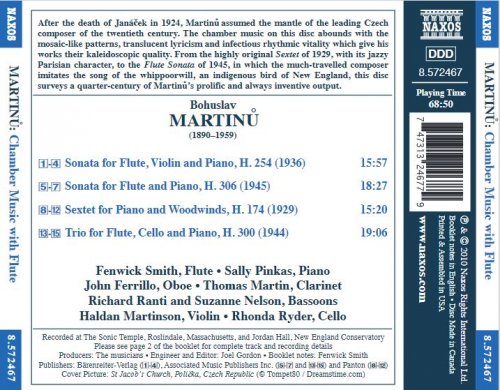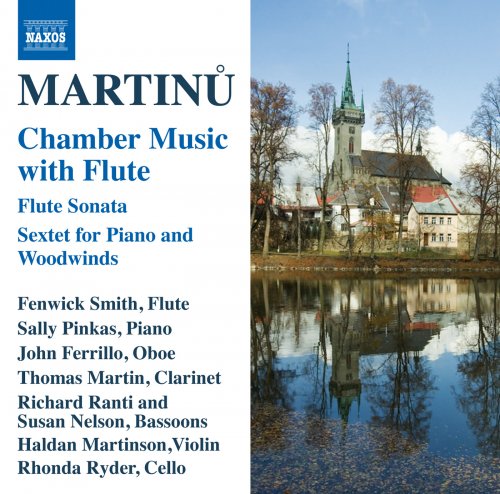
Fenwick Smith - Martinu: Chamber Music with Flute (2010) CD-Rip
BAND/ARTIST: Fenwick Smith
- Title: Martinu: Chamber Music with Flute
- Year Of Release: 2010
- Label: Naxos
- Genre: Classical
- Quality: FLAC (image+.cue,log,scans)
- Total Time: 68:50
- Total Size: 343 Mb
- WebSite: Album Preview
Tracklist:
Bohuslav Martinů (1890–1959)
[1]-[4] Sonata for Flute, Violin and Piano, H. 254 (1936)
[5]-[7] Sonata for Flute and Piano, H. 306 (1945)
[8]-[12] Sextet for Piano and Woodwinds, H. 174 (1929)
[13]-[15] Trio for Flute, Cello and Piano, H. 300 (1944)
Performers:
Fenwick Smith flute
Sally Pinkas piano
John Ferrillo oboe
Thomas Martin clarinet
Richard Ranti and Suzanne Nelson bassoons
Haldan Martinson violin
Rhonda Ryder cello

Bohuslav Martinů (1890–1959)
[1]-[4] Sonata for Flute, Violin and Piano, H. 254 (1936)
[5]-[7] Sonata for Flute and Piano, H. 306 (1945)
[8]-[12] Sextet for Piano and Woodwinds, H. 174 (1929)
[13]-[15] Trio for Flute, Cello and Piano, H. 300 (1944)
Performers:
Fenwick Smith flute
Sally Pinkas piano
John Ferrillo oboe
Thomas Martin clarinet
Richard Ranti and Suzanne Nelson bassoons
Haldan Martinson violin
Rhonda Ryder cello
This Naxos release of just a few of the chamber works by Bohuslav Martinu includes all the larger works involving the flute and piano, and despite any weightiness that statement implies, and despite the formal titles and structures of these works, there is more whimsy in these than the unsuspecting listener might expect. Martinu is considered a Czech composer, although he spent much of his career abroad, and like other Czech composers, he frequently uses elements of folk music. However, his music seems to have been equally influenced by French modern music. The results of the combination of those things, in this chamber music, are animated energy, clean lines, and tinges of Impressionistic colorings or jazz harmonies, all of which can be recognized in these performances featuring flutist Fenwick Smith, pianist Sally Pinkas, and their Boston-based colleagues. The liveliness of Martinu's writing comes primarily from his use of brief rhythmic patterns, based on Czech folk dances or sounds of nature -- as in the last movement of the Flute Sonata -- or jazz. Those short patterns are repeatedly used and are skillfully developed. The Sextet has the most elements borrowed from the jazz world, especially in the Divertimento movements. The second one, entitled Blues, is not what Americans would think of as blues, just as the Blues movement Ravel's Violin Sonata No. 2 isn't. The Sextet's theme is played by the bassoon to sound like saxophone, but it's as much Eastern European lament as it is jazz. In other places, the French aspects are clearest. The Adagio of the Trio for flute, cello, and piano, is very reminiscent of Ravel's adagios. Another key to the energy of the music, is contrast: between lyrical and spirited passages; between the timbres of the instruments. Smith, Pinkas, and the other musicians here are all used to playing in ensembles so that they know the significance of being able to work together yet give one part more of the spotlight when necessary, and to bring out the diverse elements and influences in Martinu's music yet make each movement and work a cohesive whole. Most importantly of all, they sound as if they are enjoying it all themselves.

Classical | FLAC / APE | CD-Rip
As a ISRA.CLOUD's PREMIUM member you will have the following benefits:
- Unlimited high speed downloads
- Download directly without waiting time
- Unlimited parallel downloads
- Support for download accelerators
- No advertising
- Resume broken downloads


